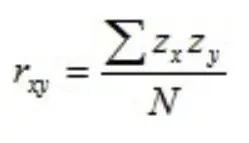Market research
The Pearson correlation coefficient is a test that measures the statistical relationship between two continuous variables. If the relationship between the elements is not linear, the coefficient will not be represented appropriately.
The correlation coefficient can take a value between +1 and -1. A value of 0 means there is no relationship between the two variables. A value greater than 0 indicates a positive relationship. This means that if the value of one variable increases, the value of the other variable also increases. A value below 0 indicates a negative relationship, meaning that as the value of one variable increases, the value of the other variable decreases.
To perform Pearson correlation, the following is required:
- The measurement scale must be an interval or ratio scale.
- The variables must be approximately distributed.
- The relationship must be linear.
- There must be no outliers in the data.
CONTENT
- 1 How do you calculate the Pearson correlation coefficient?
- 2 Interpretation of the correlation coefficient according to Karl Pearson
- 3 Advantages and disadvantages of the Pearson correlation coefficient
- 4 1:1 Live Online Presentation: QUESTIONPRO MARKET RESEARCH SOFTWARE
- 5 Try software for market research and experience management now for 10 days free of charge!
How do you calculate the Pearson correlation coefficient?
The formula for the correlation coefficient by person is as follows:
Where:
“x” represents variable number one, “y” belongs to variable number two, “zx” is the standard deviation of variable one, “zy” is the standard deviation of variable two, and “N” is the number of data.
Interpretation of the correlation coefficient according to Karl Pearson
The Pearson correlation coefficient is intended to indicate how closely two variables are related to each other, like this:
- Correlation less than zero: If the correlation is less than zero, it means that it is negative, that is, the variables are inversely related to each other. If the value of one variable is high, the value of the other variable is low. The closer it is to -1, the more obvious the extreme covariation. If the coefficient is equal to -1, it is said to have a perfect negative correlation.
- Correlation greater than zero: If the correlation is +1, it means that it is completely positive. In this case, it means that the correlation is positive, that is, the variables are directly correlated with each other. When the value of one variable is high, the value of the other variable is also high, and the same happens when they are low. If the coefficient is close to +1, it is covariation.
- Correlation equal to zero: If the correlation is zero, it means that it is not possible to determine some covariation. However, this does not mean that there is no nonlinear relationship between the variables. If the variables are independent, it means that they are correlated, but that does not mean that the result is true.
Advantages and disadvantages of the Pearson correlation coefficient
Key benefits of Karl Pearson's correlation coefficient include:
- The value is independent of the unit used to measure the variable.
- When the sample is large, the accuracy of the estimate is more likely.
Some of the disadvantages of correlation coefficient are:
- The two variables must be measured at a continuous quantitative level.
- The distribution of the variable must be similar to the normal curve.
1:1 live online presentation:
QUESTIONPRO MARKET RESEARCH SOFTWARE
Arrange an individual appointment and discover our market research software.
Try software for market research and experience management now for 10 days free of charge!
Do you have any questions about the content of this blog? Simply contact us via contact form. We look forward to a dialogue with you! You too can test QuestionPro for 10 days free of charge and without risk in depth!
Test the agile market research and experience management platform for qualitative and quantitative data collection and data analysis from QuestionPro for 10 days free of charge
FURTHER KEYWORDS
SHARE THIS ARTICLE
KEYWORDS OF THIS BLOG POST
Pearson correlation coefficient | Correlation coefficient | Pearson
FURTHER INFORMATION
- Data virtualization: what it is, advantages and benefits
- Synthetic data: what they are, types, methods and uses
- Observational data: what it is, types and use cases
- Numerical data: what are they, characteristics, types and examples
- Hard and soft data: what they are and how they differ
- Data filtering: what it is, benefits and examples
- Data collection tools: which are the best?
- Big Data and Artificial Intelligence: How do they work together?




